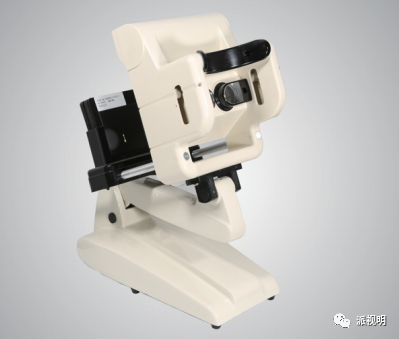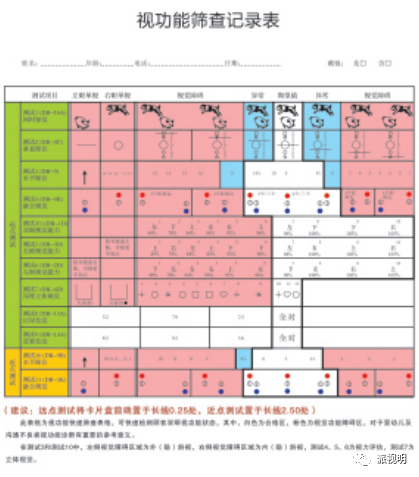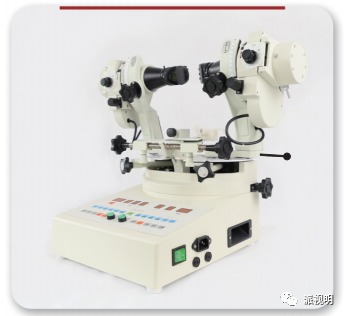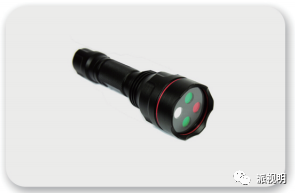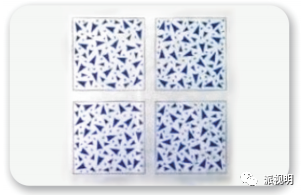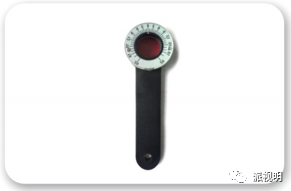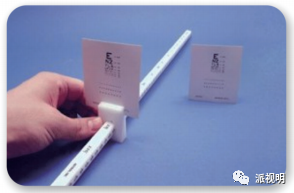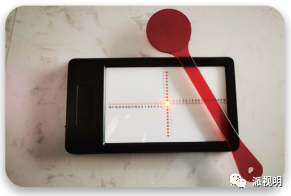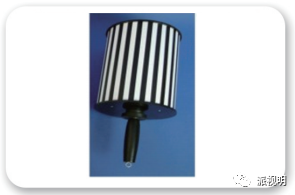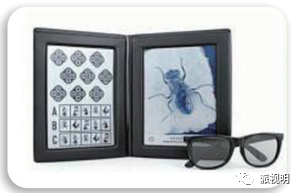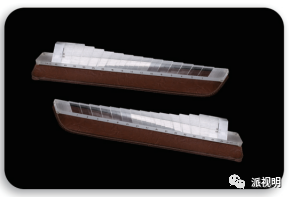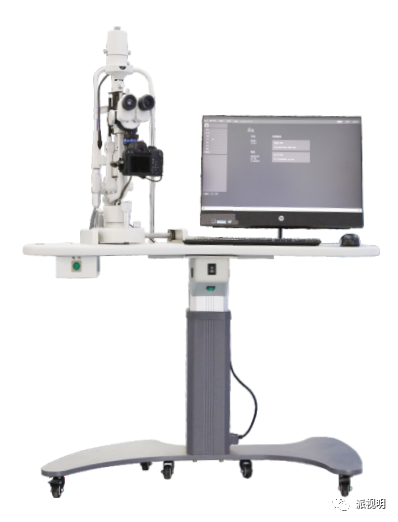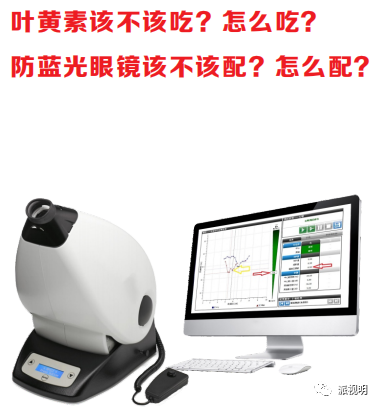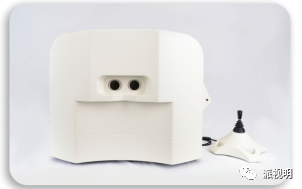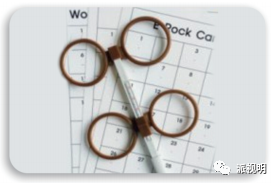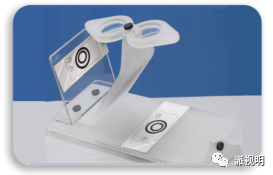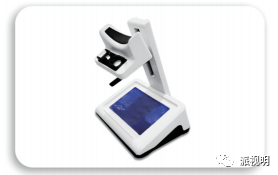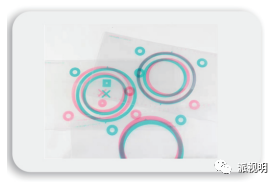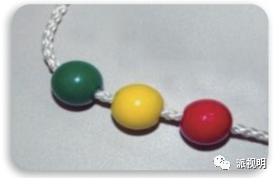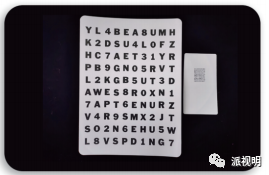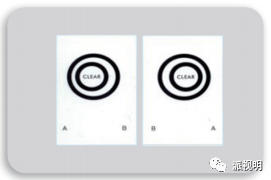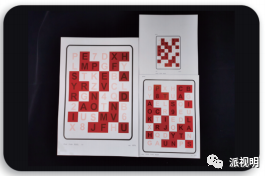Visual Function Testing Devices
-
Visual Acuity Examination Instrument
|
|
Function Principle:
This device can test most of the visual functions required in clinical practice, not just visual acuity. The test results can show whether the subject’s eyes can coordinate, whether there is simultaneous perception, fusion, whether the eye position is normal, whether the vision is normal, and even whether there is depth perception (stereopsis) and color blindness, accurately reflecting the visual status of the subject. |
|
|
Usage Instructions: The record sheet will be used to document the results of 12 comprehensive tests, represented in white, blue, or pink. The white sheet indicates passing; if there is refractive error, glasses can be prescribed directly. The blue sheet indicates abnormalities that require re-examination and therapeutic glasses or visual training. The pink sheet indicates possible visual function disorders that should be further diagnosed, and visual function training should be conducted alongside therapeutic glasses. |
-
Visual Function Testing Box
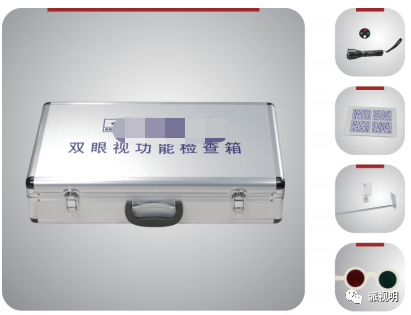 |
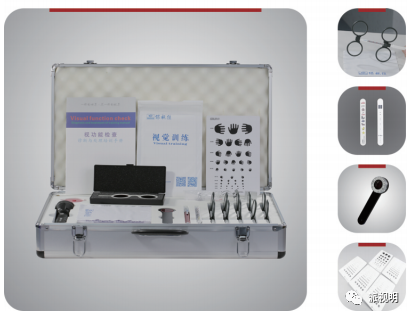 |
|
Usage Instructions: Four-hole lamp: Mainly used to check for suppression, determine primary simultaneous vision; check for diplopia, determine secondary fusion function. Stereopsis testing board: Determines stereopsis acuity. Testing can be done without wearing red-green glasses or polarized glasses. Heterophoria tester: An instrument for diagnosing abnormal eye position. Mainly used to check the prism degree of the direction of heterophoria in human eyes. Accommodation testing ruler: Based on the principle of measuring the near point using the near vision method, used to determine the accommodation function of the human eye. Adjustable double-sided mirror: Used for sensitivity adjustment checks and training. Pupillary distance range 40-80, adjustable according to the needs of different trainees. Visual acuity card: Near vision chart, portable, simple graphics, easy for children to express. Pencil light: Used to check the pupil. Near vision indicator strip: Used as a fixation target during examination to accurately judge eye movement. |
-
Synoptophore
|
|
Function Principle:
The synoptophore is a fully functional modern ophthalmic instrument used to check the three levels of visual function: primary simultaneous vision, secondary fusion vision, and tertiary stereopsis. It diagnoses subjective and objective strabismus angles, abnormal retinal correspondence, AC/A, fusion range, and other visual function checks; it can also be used for quantitative and qualitative checks of eye position, providing reliable evidence for strabismus surgery. Diagnosis and training of primary simultaneous vision, secondary fusion vision, and tertiary stereopsis; strabismus and amblyopia checks, training, and afterimage therapy. |
-
WORTH 4 Four-Hole Lamp
|
|
Performance Indicators: The four-hole lamp is designed based on the principle of complementary red and green colors. Color vision theory states that when two colors of different wavelengths are complementary, they appear black when overlapped. Clinical Uses: For patients with a difference of three lines or more in uncorrected vision between the two eyes, for those with a difference of three lines or more in corrected vision, for those with a difference of 2D or more in computer refraction between the two eyes, for those with a difference of 2D or more in prescribed glasses, and for amblyopia and strabismus patients to perform primary simultaneous vision, secondary fusion vision, and tertiary stereopsis (requires stereoscopic visual images). |
-
Stereopsis Testing Board
|
|
Performance Indicators: The stereopsis testing card can be tested without wearing red-green glasses or polarized glasses. It is suitable for young children (6 months to 3 years), preschool children, school-age children, and adults. |
-
Strabismus Testing Mirror
|
|
Performance Indicators: An instrument for diagnosing abnormal eye position, mainly used to check the direction and degree of heterophoria in human eyes. Performance indicators: 0△~20△ (prism degree), each division value is 1△. |
-
Accommodation Ruler
|
|
Performance Indicators: Based on the principle of measuring the near point using the near vision method, used to determine the accommodation function of the human eye. For individuals with binocular visual function abnormalities, accommodative myopia, and amblyopia. |
-
Tollington
|
|
Used for near distance eye position testing. |
-
Visual Motion Nystagmus Tester
|
|
Function Principle: Infants are most sensitive to striped visual targets. When a striped drum rotates in front of the subject’s eyes, the eye with vision exhibits acute nystagmus. |
-
Polarized Stereopsis Test
|
|
Function Principle: Provides 9 sets of images for qualitative and quantitative stereopsis checks based on different ages and uses, allowing for quick screening of the subject’s stereoscopic perception. Performance Indicators: Designed disparities of 400″, 200″, and 100″, with circle quantitative images, totaling 9 sets, with disparities ranging from 800″ to 40″ divided into 9 levels. |
-
Step Prism
|
|
Performance Indicators: Used for checking the degree of strabismus in strabismus patients, convenient for changing prism degrees, with 15 prism degrees for both horizontal and vertical strabismus. |
-
Digital Slit Lamp
|
|
Essential for Optometry Centers Observation of the physiological condition of the anterior segment of the eye Identifying tear film quality Fitting contact lenses Monitoring corneal integrity Assessing the quality of contact lens fitting Identifying related issues after wearing Determining lens sedimentation Used in conjunction with fundus observation |
-
Macular Pigment Analyzer
|
|
Provides a practical and intuitive assessment of the concentration of lutein in the macula, forming a consensus around the prevention of AMD and comprehensive research on juvenile vision health management, providing sound guidance.
A: Macular lutein concentration score: Very Low <0.25 – It is recommended to take high-dose lutein supplements and wear blue light blocking glasses, regardless of the presence of any other risk factors; B: Macular lutein concentration score: Very Low 0.25-0.5– If one or more key risk factors are present, please follow medical advice to take lutein and consistently wear blue light blocking glasses; C: Macular lutein concentration score: Good 0.50-0.75 – If two or more risk factors are present, please follow medical advice to take lutein and wear blue light blocking glasses when using electronic products; D: Macular lutein concentration score: Very Good >0.75 – No need to take lutein, and it is recommended to wear blue light blocking glasses when using electronic products; |
Visual Training Equipment
-
Smart Flip Mirror (Accommodation Training)
|
|
Function Principle: Personalized selection of training to adjust tension and relaxation functions, adjustable spherical lens values to enhance accommodation range and sensitivity. |
-
Adjustable Pupillary Distance Flip Mirror, Double-Sided Mirror
|
|
Function Principle: Sensitivity adjustment training, pupillary distance range 40-80, adjustable according to the needs of different trainees. Specifications: ±0.50, ±1.00, ±1.50, ±2.00, ±2.50, ±3.0 and special specifications. |
-
Fishbone Card
|
|
|
Usage Instructions: First, fold the card along the three dashed lines, placing one end of the card against the trainee’s nose tip, ensuring the line of sight and the card’s visual target are on the same horizontal line, with the trainee’s chin slightly raised, focusing on the farthest fishbone visual target on the card. At this time, the trainee should feel the same color fishbone cards merging, while the other nearby fishbone visual targets appear as two and are distributed on both sides. Alternate focusing on different distance visual targets for 10 times each. If the trainee finds it difficult to focus, they can try the following methods: suggest to the trainee that the visual target is approaching them, causing convergence, and slightly move the training card further away or down. |
-
Real Mirror
|
|
Function Principle: The oldest tool for training binocular visual function, its function has evolved from simple hand-drawn training to a comprehensive tool for training simultaneous vision, fusion, and stereopsis. |
-
BVT Stereoscope
|
|
Function Principle: Helps improve the patient’s ability to focus and fixate on spatial objects, suitable for patients whose real distance is farther than the focus distance; training improves the patient’s coordination and focusing ability for near work. Training for convergence and divergence ability: Helps improve the ability of both eyes to focus on spatial visual targets, assess binocular stability, and can also be used to establish simultaneous vision. BVT Stereoscope Fusion Range: Expands the fusion range and enhances convergence ability, achieving a more comfortable and sustained working state. |
-
Red-Green Stereoscopic Fixed Vector Image
|
|
Function Principle: Fusion training. Helps improve the patient’s binocular visual function, increasing the amplitude of positive and negative fusion, expanding the fusion range, and enhancing stereopsis. |
-
Brock Line & Convergence-Divergence Ball
|
|
Function Principle: The trainee focuses on small balls at different distances, training the convergence and divergence ability of both eyes, mainly targeting patients with exodeviation. |
-
Alphabet Exercise
|
|
Function Principle: Training accommodation ability, enhancing accommodation range. |
-
Excentric Ring
|
|
Function Principle: Training the convergence and fusion ability of both eyes. |
-
Anti-Suppression Card
|
|
Function Principle: De-suppression, establishing simultaneous vision. |
-
Slit Gauge
|
|
|
Function Principle: The basic principle is the use of “holes” to achieve the goal that one eye can only see part of the visual target while the other eye can only see another part of the visual target, thus separating the two eyes. It increases the ability to adjust relative motion between the two eyes, maximizing convergence and divergence functions for sustained comfortable work. Divergence Training: Observe a card with a single pattern, following the prompts on the card, position the double-hole board accordingly, align the nose with the sliding ruler, and observe with both eyes until the pattern on the card merges into 12. If there is difficulty, cover one eye until the pattern merges into one. Convergence Training: Observe a card with two patterns, following the prompts on the card, position the single-hole board accordingly, align the nose with the sliding ruler, and observe with both eyes until the two patterns merge into one. If there is difficulty, cover one eye until the pattern merges into one. |
Different devices (equipment), functions, and principles are sometimes similar. For optical shops upgrading to optometry, in addition to improving their refraction skills and conducting visual function checks, they also need to possess the ability to analyze and prescribe, with equipment and tools used to assist in training and controlling myopia. Furthermore, they need to have comprehensive capabilities, including the fitting of myopia control lenses and other auxiliary treatments. PAI Vision provides professional multi-focal lenses and comprehensive after-sales service, helping to make optical services more complete and systematic. For lens procurement, please consult customer service..
